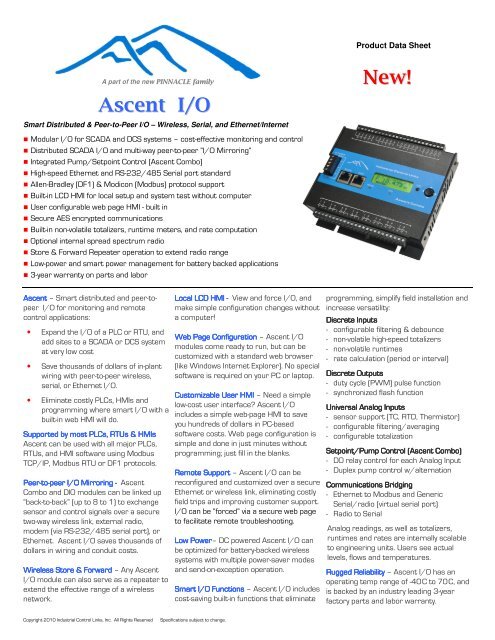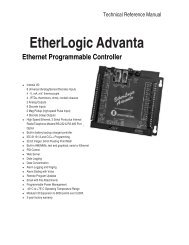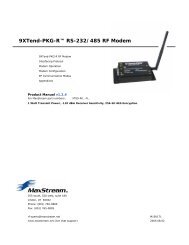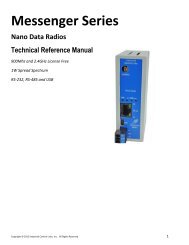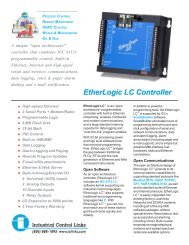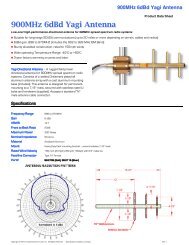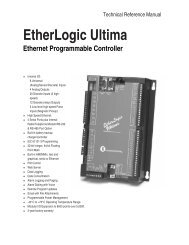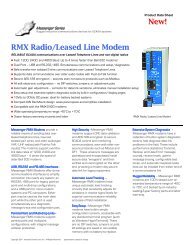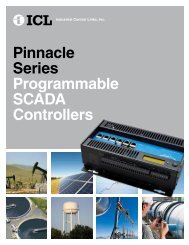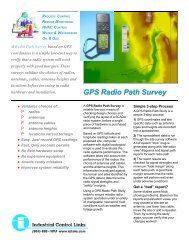Data Sheet (PDF) - Industrial Control Links
Data Sheet (PDF) - Industrial Control Links
Data Sheet (PDF) - Industrial Control Links
Create successful ePaper yourself
Turn your PDF publications into a flip-book with our unique Google optimized e-Paper software.
Product <strong>Data</strong> <strong>Sheet</strong><br />
A part of the new PINNACLE family<br />
Ascent I/O<br />
Smart Distributed & Peer-to-Peer I/O – Wireless, Serial, and Ethernet/Internet<br />
Modular I/O for SCADA and DCS systems – cost-effective monitoring and control<br />
Distributed SCADA I/O and multi-way peer-to-peer ”I/O Mirroring”<br />
Integrated Pump/Setpoint <strong>Control</strong> (Ascent Combo)<br />
High-speed Ethernet and RS-232/485 Serial port standard<br />
Allen-Bradley (DF1) & Modicon (Modbus) protocol support<br />
Built-in LCD HMI for local setup and system test without computer<br />
User configurable web page HMI - built in<br />
Secure AES encrypted communications<br />
Built-in non-volatile totalizers, runtime meters, and rate computation<br />
Optional internal spread spectrum radio<br />
Store & Forward Repeater operation to extend radio range<br />
Low-power and smart power management for battery backed applications<br />
3-year warranty on parts and labor<br />
New!<br />
Ascent – Smart distributed and peer-topeer<br />
I/O for monitoring and remote<br />
control applications:<br />
• Expand the I/O of a PLC or RTU, and<br />
add sites to a SCADA or DCS system<br />
at very low cost<br />
• Save thousands of dollars of in-plant<br />
wiring with peer-to-peer wireless,<br />
serial, or Ethernet I/O.<br />
• Eliminate costly PLCs, HMIs and<br />
programming where smart I/O with a<br />
built-in web HMI will do.<br />
Supported by most PLCs, RTUs & HMIs<br />
Ascent can be used with all major PLCs,<br />
RTUs, and HMI software using Modbus<br />
TCP/IP, Modbus RTU or DF1 protocols.<br />
Peer-to<br />
to-peer I/O Mirroring - Ascent<br />
Combo and DIO modules can be linked up<br />
“back-to-back” (up to 8 to 1) to exchange<br />
sensor and control signals over a secure<br />
two-way wireless link, external radio,<br />
modem (via RS-232/485 serial port), or<br />
Ethernet. Ascent I/O saves thousands of<br />
dollars in wiring and conduit costs.<br />
Wireless Store & Forward – Any Ascent<br />
I/O module can also serve as a repeater to<br />
extend the effective range of a wireless<br />
network.<br />
Local LCD HMI - View and force I/O, and<br />
make simple configuration changes without<br />
a computer!<br />
Web Page Configuration – Ascent I/O<br />
modules come ready to run, but can be<br />
customized with a standard web browser<br />
(like Windows Internet Explorer). No special<br />
software is required on your PC or laptop.<br />
Customizable User HMI – Need a simple<br />
low-cost user interface? Ascent I/O<br />
includes a simple web-page HMI to save<br />
you hundreds of dollars in PC-based<br />
software costs. Web page configuration is<br />
simple and done in just minutes without<br />
programming; just fill in the blanks.<br />
Remote Support – Ascent I/O can be<br />
reconfigured and customized over a secure<br />
Ethernet or wireless link, eliminating costly<br />
field trips and improving customer support.<br />
I/O can be “forced” via a secure web page<br />
to facilitate remote troubleshooting.<br />
Low Power– DC powered Ascent I/O can<br />
be optimized for battery-backed wireless<br />
systems with multiple power-saver modes<br />
and send-on-exception operation.<br />
Smart I/O Functions – Ascent I/O includes<br />
cost-saving built-in functions that eliminate<br />
programming, simplify field installation and<br />
increase versatility:<br />
Discrete Inputs<br />
- configurable filtering & debounce<br />
- non-volatile high-speed totalizers<br />
- non-volatile runtimes<br />
- rate calculation (period or interval)<br />
Discrete Outputs<br />
- duty cycle (PWM) pulse function<br />
- synchronized flash function<br />
Universal Analog Inputs<br />
- sensor support (TC, RTD, Thermistor)<br />
- configurable filtering/averaging<br />
- configurable totalization<br />
Setpoint/Pump<br />
<strong>Control</strong> (Ascent Combo)<br />
- DO relay control for each Analog Input<br />
- Duplex pump control w/alternation<br />
Communications Bridging<br />
- Ethernet to Modbus and Generic<br />
Serial/radio (virtual serial port)<br />
- Radio to Serial<br />
Analog readings, as well as totalizers,<br />
runtimes and rates are internally scalable<br />
to engineering units. Users see actual<br />
levels, flows and temperatures.<br />
Rugged Reliability – Ascent I/O has an<br />
operating temp range of -40 C to 70 C, and<br />
is backed by an industry leading 3-year<br />
factory parts and labor warranty.<br />
Copyright 2010 <strong>Industrial</strong> <strong>Control</strong> <strong>Links</strong>, Inc. All Rights Reserved<br />
Specifications subject to change.
Ascent I/O<br />
Ascent I/O Modules in a SCADA or DCS System<br />
Internet<br />
Ethernet<br />
Router<br />
HMI<br />
Computer<br />
Ethernet<br />
Repeater<br />
SCADA<br />
PLC<br />
RS-232<br />
RS-485<br />
Modbus or DF1<br />
HMI Terminal<br />
Modbus or DF1 Serial I/O<br />
Ascent I/O modules have independent Ethernet, Serial (RS-232 and RS-485) and internal radio (option) communications ports. The<br />
ports may be used simultaneously. For example, a local Modbus HMI terminal can be connected locally to an I/O module to show<br />
levels and flows on the door of the panel housing an Ascent module, while an HMI computer or PLC is talking to the Ascent module<br />
over an Ethernet or wireless link. To extend the effective range of a wireless network, Ascent modules can act as intelligent repeaters,<br />
using either the internal radios, or external radios connected to the serial port.<br />
Ascent modules can also bridge communications between ports. In the diagram above, an HMI computer or SCADA PLC can talk to<br />
Modbus (serial) I/O modules via an Ethernet or wireless connection, or both, saving the cost of additional radios. Bridging is supported<br />
from Ethernet to serial, Ethernet to wireless, and serial to wireless.<br />
Ascent I/O Modules “Mirroring” I/O over Ethernet, the Internet, or Wireless Link<br />
Ascent I/O Combo and DIO modules can also be used in a peer-to-peer or “mirror-mode” configuration where 1 to 8 modules pass<br />
I/O information to a single Ascent module. Analog and Discrete inputs are “repeated” or mirrored as Analog and Discrete Outputs in<br />
both directions (2-way). In addition to I/O levels, all tag names, units, etc. as well as associated totalizer, rate and runtime<br />
measurements are available for display on the local LCD HMIs or by communications at either ends of the links. Mirroring works over<br />
Ethernet, the Internet, a wireless link, or via external modems or radios connected to the Ascent module serial ports.<br />
One or more PC computers can<br />
access local web HMI pages in<br />
any of the Ascent modules<br />
See all I/O information with<br />
the built-in web HMI!<br />
Ethernet LAN or<br />
the Internet<br />
I/O and<br />
Repeater<br />
Mirroring over an Ethernet network or the Internet<br />
Mirroring over a Wireless Network (with one node as a Repeater)<br />
Copyright 2010 <strong>Industrial</strong> <strong>Control</strong> <strong>Links</strong>, Inc. All Rights Reserved Specifications subject to change. Rev 1.1a
Ascent I/O<br />
Combo<br />
Ascent Combo – a symmetrical mixture of analog and discrete I/O;<br />
ideal for peer-to-peer mirrored I/O as well as distributed I/O<br />
applications. In addition, the Ascent Combo module has setpoint<br />
control, duplex pump control and alarming capabilities, and the<br />
Universal Inputs may be internally “routed” to the analog outputs to<br />
function as up to 8 configurable signal conditioners/transmitters.<br />
8 Universal Inputs<br />
I<br />
are individually “soft” configurable through the builtin<br />
LCD or web page HMI; no switches or jumpers. Each input accepts<br />
standard process signals (mA, mV or V), measures resistance, and<br />
reads thermocouples, thermistors or RTD temperature sensors.<br />
Conversion speed and averaging are configurable on every input to<br />
optimize response times and noise rejection. Each input can be scaled<br />
to engineering units.<br />
8 Analog Outputs provide high-resolution 20mA outputs, or provide a<br />
voltage output when used with an external resistor. An internal 24v<br />
loop supply is independent of the supply voltage.<br />
10 Discrete Inputs – rugged optically isolated inputs available in 12-24v or 120-240v configurations. Each input includes its own nonvolatile<br />
32-bit totalizers and runtime accumulators, for keeping track of total flow or machine cycles, and motor and pump runtimes. In<br />
addition, pulse rates are calculated on each input, either by measuring the number of pulses over time period, or measuring the<br />
interval between pulses (Rate = 1/Time). The method used depends on the input frequency range and the desired update rate and<br />
measurement resolution. All measurements can be scaled to engineering, offloading calculations from a host PLC. This provides a<br />
meaningful user friendly display on the local LCD HMI and built-in web page HMI.<br />
10 Discrete Outputs provide relay dry contacts with programmable flashing, precision one-shot pulse and PWM control.<br />
Ascent Combo I/O Module Specifications<br />
Analog Inputs<br />
I<br />
8<br />
Resolution<br />
16-bit (24-bit internal)<br />
Input/Sensor Types: 20mA, 0 to 2 Volts, +/-250 mV, Ohms, Thermocouple (Type J, K, T, E, R, S, B, N)<br />
Thermistor (10K, II & III), RTD 2 and 3-wire (10,100, 1K ohm) note: 3-wire RTDs require 2 inputs each<br />
Measurement Averaging Individually configurable by input; 1, 2, 4, 8, 16, 32 samples, “boxcar” technique<br />
Conversion Speed<br />
User configurable; 7.5 to 4000 samples per second, per 8 inputs<br />
Input Functions (each Input) Accumulator (integrate/totalize input with 1 to 255 sec sampling interval)<br />
Analog Outputs 8<br />
Resolution/Type<br />
16-bit , 0/4 to 20mA (voltage output with external resistor)<br />
Discrete Inputs<br />
I<br />
10<br />
Type<br />
Optically Isolated<br />
Input Ranges<br />
Order as 12/24V (up to 30Vdc/Vac), or 120V/240V (up to 260Vac)<br />
Input Conditioning<br />
Programmable Filtering/Delay (0 to 65,535mS)<br />
Runtime<br />
1 32-bit non-volatile timer per input, configurable to read in seconds, tenths of minutes and tenths of hours<br />
Totalizers<br />
1 32-bit non-volatile high-speed counter per input, (5KHz Max.)<br />
Rate Measurement<br />
Dual mode (Sample Period or 1/frequency)<br />
1 to 255 second sample period, 0 to 65,535mS (1/F measurement technique)<br />
Discrete Outputs 10<br />
Type<br />
Relay contact, 3A max. per output<br />
Output Functions (each output) Flash (synchronized with other outputs)<br />
Pulse (one-shot) 1 to 65,535mS,<br />
PWM - programmable On/Off times – 1 to 65,535mS each<br />
Copyright 2010 <strong>Industrial</strong> <strong>Control</strong> <strong>Links</strong>, Inc. All Rights Reserved Specifications subject to change. Rev 1.1a
Ascent I/O<br />
UI-32<br />
Ascent UI-32<br />
– providing 32 Universal Analog Inputs. Each of the<br />
inputs are individually “soft” configurable through the built-in LCD or<br />
web page HMI; no switches or jumpers. Each input can be scaled to<br />
engineering units, offloading calculations from a host PLC. This<br />
provides a meaningful user friendly display on the local LCD HMI and<br />
built-in web page HMI.<br />
32 Universal Inputs, individually “soft” configurable through the built-in<br />
LCD or web page HMI - no switches or jumpers. Each input may be<br />
configured to accept standard process signals (mA, mV or V),<br />
resistance, or thermocouple, thermistor or RTD temperature sensor.<br />
Conversion speed and built-in box car averaging are also configurable<br />
by channel in order to optimize response times and noise rejection.<br />
This also helps to offload processing overhead from PLC or DCS<br />
systems.<br />
Each group of eight inputs can be sampled up to 4000 times per<br />
second for an aggregate maximum sampling rate of 16,000 readings<br />
per second across all 32 inputs! The high conversion speed combined<br />
with a high-speed Ethernet interface makes these modules ideal for<br />
large distributed control and monitoring systems. The ability to “talk”<br />
multiple industry standard protocols makes these modules a low-cost<br />
alternative to expensive PLC and DCS system analog input modules.<br />
Ascent UI-32 Universal input Module Specifications<br />
Analog Inputs<br />
Quantity 32<br />
Resolution<br />
16-bit (24-bit internal)<br />
Input/Sensor Types: 20mA, 0 to 2 Volts, +/-250 mV, Ohms, Thermocouple (Type J, K, T, E, R, S, B, N)<br />
Thermistor (10K, II & III), RTD 2 and 3-wire (10,100, 1K ohm) note: 3-wire RTDs require 2 inputs each<br />
Measurement Averaging Individually configurable by input; 1, 2, 4, 8, 16, 32 samples, “boxcar” technique<br />
Conversion Speed<br />
User configurable; 7.5 to 4000 samples per second, per 8 inputs<br />
Input Functions (each Input) Accumulator (integrate/totalize input with 1 to 255 sec sampling interval)<br />
Copyright 2010 <strong>Industrial</strong> <strong>Control</strong> <strong>Links</strong>, Inc. All Rights Reserved Specifications subject to change. Rev 1.1a
Ascent I/O<br />
DIO - 22/22<br />
Ascent DIO-22/22<br />
– a symmetrical mixture of discrete inputs and<br />
outputs; ideal for peer-to-peer mirrored I/O as well as distributed I/O<br />
applications.<br />
22 Discrete Inputs – rugged optically isolated inputs available in 12-<br />
24v or 120-240v configurations. Each input includes its own nonvolatile<br />
32-bit totalizer for keeping track of total flow or machine cycles,<br />
and a non-volatile 32-bit runtime meter, to keep track of motor and<br />
pump runtimes. In addition, pulse rates are calculated on each input,<br />
either by measuring the number of pulses over time period, or<br />
measuring the interval between pulses (Rate = 1/Time). The method<br />
used depends on the input frequency range and the desired update<br />
rate and measurement resolution. All measurements can be scaled to<br />
engineering, offloading calculations from a host PLC. This provides a<br />
meaningful user friendly display on the local LCD HMI and built-in web<br />
page HMI.<br />
22 Discrete Outputs provide relay dry contacts with programmable<br />
flashing, precision one-shot pulse and PWM control functions. The<br />
flashing function provides a synchronized flash output whose time<br />
period is programmable, but common to all flashing outputs. This is<br />
used primarily to operate flashing alarm indicators. Every output also<br />
supports a one-shot pulse function; each time the channel is activated,<br />
the output turns on for a precision length of time, and then turns off<br />
automatically. This type of operation is frequently used with motorized<br />
actuators to move them a prescribed distance, independent of<br />
communications latency. The outputs also support PWM (Pulse Width<br />
Modulated) operation, where the output toggles on and off for a<br />
precision period of time, and where each channels on and off time can<br />
be set independently. This operation is used for heater and metering<br />
pump controls, frequently as part of some closed loop control system.<br />
Ascent DIO 22/22 Input/Output Module Specifications<br />
Discrete Inputs 22<br />
Type<br />
Optically Isolated<br />
Input Ranges<br />
Order as 12/24V (up to 30Vdc/Vac), or 120V/240V (up to 260Vac)<br />
Input Conditioning<br />
Programmable Filtering/Delay (0 to 65,535mS)<br />
Runtime<br />
1 32-bit non-volatile timer per input, configurable to read in seconds, tenths of minutes and tenths of hours<br />
Totalizers<br />
1 32-bit non-volatile high-speed counter per input, (5KHz Max.)<br />
Rate Measurement<br />
Dual mode (Sample Period or 1/frequency)<br />
1 to 255 second sample period<br />
0 to 65,535mS (1/F measurement technique)<br />
Discrete Outputs 22<br />
Type<br />
Relay contact, 3A max. per output<br />
Output Functions (each output) Flash (synchronized with other outputs)<br />
Pulse (one-shot) 1 to 65,535mS,<br />
PWM - programmable On/Off times – 1 to 65,535mS each<br />
Copyright 2010 <strong>Industrial</strong> <strong>Control</strong> <strong>Links</strong>, Inc. All Rights Reserved Specifications subject to change. Rev 1.1a
Ascent I/O<br />
DI - 44<br />
Ascent DI-44<br />
– a Discrete Input module that provides an economical<br />
means of monitoring a large number of Discrete Input sensors at a<br />
location. Local processing offloads most realtime response constraints<br />
of communications without missing a single transition or accurately<br />
measuring rates and runtimes.<br />
44 Discrete Inputs – rugged optically isolated inputs available in 12-<br />
24v or 120-240v configurations. Each input includes its own nonvolatile<br />
32-bit totalizer for keeping track of total flow or machine cycles,<br />
and a non-volatile 32-bit runtime meter, to keep track of motor and<br />
pump runtimes. In addition, pulse rates are calculated on each input,<br />
either by measuring the number of pulses over time period, or<br />
measuring the interval between pulses (Rate = 1/Time). The method<br />
used depends on the input frequency range and the desired update<br />
rate and measurement resolution. All measurements can be scaled to<br />
engineering, offloading calculations from a host PLC. This provides a<br />
meaningful user friendly display on the local LCD HMI and built-in web<br />
page HMI.<br />
Ascent DI-44 Input Module Specifications<br />
Discrete Inputs 44<br />
Type<br />
Optically Isolated<br />
Input Ranges<br />
Order as 12/24V (up to 30Vdc/Vac), or 120V/240V (up to 260Vac)<br />
Input Conditioning<br />
Programmable Filtering/Delay (0 to 65,535mS)<br />
Runtime<br />
1 32-bit non-volatile timer per input, configurable to read in seconds, tenths of minutes and tenths of hours<br />
Totalizers<br />
1 32-bit non-volatile high-speed counter per input, (5KHz Max.)<br />
Rate Measurement<br />
Dual mode (Sample Period or 1/frequency)<br />
1 to 255 second sample period<br />
0 to 65,535mS (1/F measurement technique)<br />
Copyright 2010 <strong>Industrial</strong> <strong>Control</strong> <strong>Links</strong>, Inc. All Rights Reserved Specifications subject to change. Rev 1.1a
Ascent I/O<br />
Ascent I/O – Common Specifications<br />
Communications, Networking & HMI<br />
Ethernet<br />
Protocol support<br />
Security<br />
10 BaseT<br />
Modbus TCP (Slave), Modbus UDP (Slave), HTTP, ARP, SDX (ICL), Serial Port Forwarding to serial port or internal radio<br />
128-bit AES encryption using SDX protocol<br />
Separate passwords on user and configuration web pages.<br />
Serial Port<br />
<strong>Data</strong> rate<br />
Protocol support<br />
Security<br />
RS-232 and RS-485<br />
2400 baud to 115K baud<br />
Modbus RTU Slave (Modicon), DF1 (Allen-Bradley), SDX (ICL), Store & Forward (Modbus & SDX)<br />
128-bit AES encryption<br />
Internal Radio (optional)<br />
Radio type<br />
Freewave<br />
MDS<br />
Digi/Maxstream<br />
Modes of Operation:<br />
Output power<br />
<strong>Data</strong> rate<br />
Antenna Connection:<br />
Protocol support<br />
Security<br />
Choice of 3 radios; Digi (Xtend), Freewave (MR2), or MDS (Transnet)<br />
902MHz to 928MHz Spread Spectrum, frequency hopping, (plus MESH networking with Digi Xtend radio)<br />
Sensitivity: -108dBm (BER 10 -6 ), 32-bit CRC, point to multipoint, network diagnostics, FGR-115 compatible<br />
Sensitivity: -108dBm (BER 10 ), 16-bit CRC, point to multipoint, network diagnostics, Transnet compatible<br />
-6<br />
Sensitivity: -110dBm @9600 baud, -100dBm @115K baud, point to multipoint & peer to peer, DigiMesh<br />
Point to multipoint (all models), peer to peerand mesh (Digi Xtend only)<br />
1Watt maximum (user settable down to 100mW)<br />
115K or 9600 baud, over the air<br />
Reverse polarity SMA<br />
Modbus RTU Slave (Modicon), DF1 (Allen-Bradley), SDX (ICL), Store & Forward (Modbus & SDX)<br />
256-bit AES encryption on all over-the-air messaging, plus128-bit AES encryption on SDX messages<br />
Local HMI<br />
Web HMI<br />
General<br />
Watchdog Timers<br />
Terminal Blocks<br />
Mounting<br />
Dimensions<br />
Environment<br />
Power<br />
Warranty<br />
Display:122x32 Graphic LCD w/backlight (4 lines x 20 characters max. in character mode)<br />
Input: 5 Axis navigation Switch plus “Escape” pushbutton switch<br />
HTML web pages; separate security access for configuration and users<br />
Communications (individually configurable by port). Resets outputs to individually user defined states.<br />
CPU – Ensures “sanity” of internal processor operation<br />
Removable, 3.5mm (0.138”), 12 to 22AWG, 15A/contact maximum<br />
35mm. DIN rail or panel mount<br />
6.2”W x 6.2”H x 2.4”D (includes terminal blocks and elevation off panel on DIN rail)<br />
- 40 o F(- 40 o C) to 158 o F (70 o C), 5%RH to 95% RH, non-condensing<br />
10 to 30Vdc<br />
Power consumption varies by module type, active outputs, and radio operation (internal radio option). With<br />
Ethernet OFF; 30mA typical. @ 12Vdc (Dos and AOs off), 400mA max. (radio transmit, maximum AOs/DOs ON)<br />
Ethernet ON (without radio): 100mA typical. @ 12Vdc (Dos and AOs off), 500mA max. @ 12Vdc (AOs/DOs ON)<br />
3 years, factory parts and labor<br />
1 2 3 4 5 6 7 8 9 10 11 12 13 14 15 16 17 18 19 20 21 22 23 24<br />
2.4"<br />
6.2"<br />
6.2"<br />
Copyright 2010 <strong>Industrial</strong> <strong>Control</strong> <strong>Links</strong>, Inc. All Rights Reserved Specifications subject to change. Rev 1.1a
Ascent I/O<br />
For the perfect complement to the Ascent I/O modules . . .<br />
. . . check out the new Pinnacle family of programmable SCADA controllers.<br />
Everest<br />
300MHz 32-bit CPU, Real Time Clock/Calendar<br />
128MB RAM, 512MB Flash Disk (expandable to 2TB)<br />
1 10/100 Ethernet<br />
4 USB<br />
5 Serial Ports (4 x RS-232, 1 x RS-232/RS-485)<br />
Optional internal radio and telephone modem<br />
Base I/O: 8 Universal Analog inputs<br />
1 Analog input / UPS Battery Input<br />
4 Analog Outputs<br />
4 Digital I/O (Low voltage & high-speed counters)<br />
2 High-speed Pulse/Magnetic Pickup Inputs<br />
20 Digital Inputs, Optically Isolated<br />
12 Digital Outputs, Relay<br />
Shasta<br />
300MHz 32-bit CPU, Real Time Clock/Calendar<br />
128MB RAM, 512MB Flash Disk (expandable to 2TB)<br />
1 10/100 Ethernet<br />
2 USB<br />
3 Serial Ports (2 x RS-232, 1 x RS-232/RS-485)<br />
Optional internal radio and telephone modem<br />
Base I/O: 8 Universal Analog inputs<br />
1 Analog input / UPS Battery Input<br />
2 Analog Outputs<br />
2 Digital I/O, Low voltage and Hgh-speed counters<br />
1 High-speed Pulse/Magnetic Pickup Inputs<br />
16 Digital Inputs, Optically Isolated<br />
6 Digital Outputs, Relay<br />
Rubicon<br />
300MHz 32-bit CPU, Real Time Clock/Calendar<br />
128MB RAM, 512MB Flash Disk (expandable to 2TB)<br />
1 10/100 Ethernet<br />
2 USB<br />
3 Serial Ports (2 x RS-232, 1 x RS-232/RS-485)<br />
Lassen<br />
Base I/O: 4 Universal Analog inputs<br />
2 Analog Outputs<br />
1 High-speed Pulse/Magnetic Pickup Inputs<br />
20 Digital Inputs, Optically Isolated<br />
10 Digital Outputs, Relay<br />
300MHz 32-bit CPU, Real Time Clock/Calendar<br />
128MB RAM, 512MB Flash Disk (expandable to 2TB)<br />
1 10/100 Ethernet<br />
2 USB<br />
Base I/O: 2 Universal Analog inputs<br />
1 Analog input<br />
2 Analog Outputs<br />
6 Digital Inputs, Low voltage and Hgh-speed counters<br />
6 Digital I/O, Low voltage<br />
1 High-speed Pulse/Magnetic Pickup Inputs<br />
Represented by:<br />
<strong>Industrial</strong> <strong>Control</strong> <strong>Links</strong>, Inc.<br />
www.iclinks.com<br />
Tel: 530-888-1800<br />
Copyright 2010 <strong>Industrial</strong> <strong>Control</strong> <strong>Links</strong>, Inc. All Rights Reserved Specifications subject to change. Rev 1.1a


